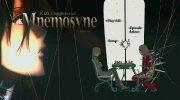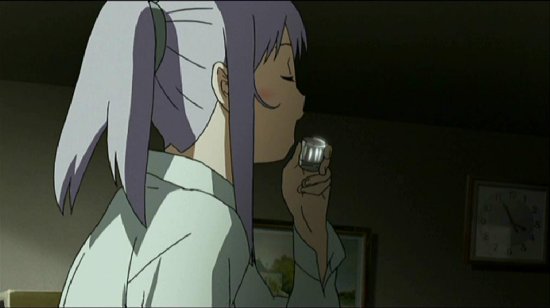Review for Rin - Daughters Of Mnemosyne: The Complete Series (2 Discs)
Introduction
Do you remember Manga Video? Back before someone invented the shiny disc we call DVD, a hefty spool of magnetic tape served all our home entertainment needs, and it made sense to use that fact in merchandising and logo, hence the precursor to Manga Entertainment that was Manga Video, and the videos that they used to sell would have tabloid readers steaming at the ears, the Mary Whitehouse brigade marching on parliament, and the odd phenomenon of cartoons next to the soft porn in HMV and Virgin. It's understandable too, as back then anime used to be sold for shock value, and for every bona fide classic like Akira, there would be half a dozen tentacular spectaculars like Urotsukidoji, or Genocyber. Back then, sex, violence, and tentacles sold, and if all three were present in the one title, all the better. A 15 rating was the least that a show should get, 18 would have been better, and if it had the notoriety of BBFC enforced cuts, perfect. Even innocuous affairs like Appleseed would get undeserved and inaccurate profane dubs to nudge that rating up. Of course those days are long past, and the majority of the anime that is released on our shores today would hardly raise an eyebrow, especially when general audiences are entertained today by fare like the Saw movies. Even Manga Entertainment, once bastion of all that is unholy and soul warping in anime, now releases wholesome fare like Fullmetal Alchemist, thought provoking social observation like Death Note, and the epitome of sweetness and light like Ah! My Goddess.
There is a part of me that misses the bad old days. You knew where you stood with anime back then, you knew there would be shock value, you knew that this wasn't for kids, and you knew that things were bound to get nasty, exploitative, and juicy. This was pre-moe, when anime creators went for the gut instead of the heart, and it would be a rare show that didn't have some sort of blood, splatter and gore. Of course here's the rub. The blood, splatter and gore, in a couple of cases like Ninja Scroll and Cyber City, were used to enhance a good storyline. Sex and violence could be used effectively to tell a story as in Perfect Blue. But in the majority of instances, it just replaced the story. Looking back at some of the anime I still have from that period, a lot of it is not very good, whereas if the anime industry has learned something in the past twenty years, it's how to spin a good yarn. I've often wondered what kind of anime would result if a modern depth of storytelling and character development was applied to the blood and guts style of nineties anime. Last year's Shigurui: Death Frenzy was one such example, although for me it was lacking in overall narrative. My eyes and ears perked up when I heard of Rin - Daughters of Mnemosyne though, as it seemed to have the sex and violence pedigree of all those classic nineties anime, but with a good story to boot, and reading up on the show's content, it became clear that this was a show that pushed modern sensibilities and boundaries to the limit. And just like those classic shows of the nineties, these episodes are made to run a full hour on TV, not just half.
Rin - Daughters of Mnemosyne was going to be released early last year by 4Digital Asia (they who tried to release Grotesque, which the BBFC banned), but before they could, Funimation licensed it in the US, and announced the dub. This was around the time that Funimation started distributing in the UK through Manga, and subsequently the UK release rights went to them. It was then a case of waiting like a nervous expectant father in a maternity ward for the BBFC to scrutinise it, and against all the odds, Mnemosyne was passed uncut. Here then are all six, uncut episodes of Rin - Daughters of Mnemosyne, presented across two DVDs.
01. Cats Don't Laugh
1990, Shinjuku. A woman wearing just a jacket is chased up some stairs by a redhead with a shotgun. Although she's hit in the shoulder, she manages to make her way to the roof of the skyscraper, and tries to leap across to a neighbouring building. She doesn't quite make it, and is left hanging off the edge. The redhead takes her time, aims, and shoots, and the woman falls to her death, several storeys below. A few seconds later, her hand slips from the ledge and follows its owner down. The next morning, private detective Rin Asogi wakes up, hale and hearty again, although nursing one hell of a headache for which vodka is the only cure, delivered by her deceptively young partner Mimi. Rin is immortal, which you would think would be of use in her line of work, but when her cases, such as her current one, involve tracking down a missing cat, you have to wonder just how much use? Instead of a cat though, she finds a tanker crash, a bunch of yakuza thugs, and Kouki Maeno, a young man with a mysterious past. It's not that he can't remember who he is, it's that he feels that his memories are not his own. Backtracking the yakuza leads to Aoyama Pharmaceuticals and a research lab in Sayama. A twisted doctor, Sayara Yamanobe is experimenting into cloning and memory transference, all in the hope of discovering immortality. That piques Rin's interest. But, Sayara also gets off on torturing and mutilating her test subjects, which isn't Rin's cup of vodka at all.
02. Angels Don't Cry
1991, and Kouki has settled down as an employee of Asogi Consulting. He even handles cases now, and when he meets a girl weeping near a skyscraper window, he picks up the oddest of cases. Yuki wants him to find an angel. Her brother is missing, and the last thing that she saw when he vanished was what looked like an angel. Rin has a far more tangible case to follow. She's been hired to find a rare stamp, which seems like a fairly straightforward and safe endeavour. She even knows just the person to see, a former stock market investor who's recently had a turn of bad luck, but who still has a few enthusiasms. But suddenly, a whole gaggle of corpses are turning up, with the word 'Angel' scrawled in blood near the bodies, and among them is the man who hired Rin in the first place. The thing is that Kouki doesn't know about Rin being immortal yet. He doesn't know about how they are created by Time Fruits, he doesn't know that angels are more real than he could possibly imagine, and he doesn't know the forces that drive angels and immortals to mutual destruction. He's about to get a crash course. And that redhead is still trying to kill Rin, urged on by a mysterious figure called Apos.
03. Flowers Don't Shed Tears
2011, and a serial bomber is wreaking havoc in Tokyo. Asogi Consulting has other concerns though. Kouki may be middle aged now, he may have settled down and raised a family, but he's still in the detective game, and his current case is a blast from his past, as an old college friend has vanished. Meanwhile, Rin gets an enigmatic phone call that leads to a rooftop encounter with a strange schoolgirl. She manages to blurt out a warning, "The flower of death is going to bloom in Tokyo", before leaping to her death. But the post-mortem reveals that she was dying anyway, infected with an unidentifiable pathogen. That, and the enigmatic message sparks a memory in Rin, of a place called Death Island, where back in 1945 the military was researching the Equinox disease. Both the disease, and the island were eradicated by volcanic activity, but somehow the disease has appeared again. The disease, the serial bombings, and the disappearance of Kouki's friend are all tied together by an evil eye tattoo. Someone who should have died twenty years ago is back, with a plan to reshape the world about to take effect. Meanwhile, Apos is manipulating the Immortals and the Angels for his own obscure purposes.
04. Ghosts Don't Scream
2025, and an earthquake means that Shinjuku is in the midst of reconstruction. Rin's offices are listed for demolition, and the populace in the grip of a recession. Fortunately for everyone, there is the escape of 2.0, the virtual reality world where people can live out their wildest fantasies. For the average guy though, that amounts to a whole lot of no-strings sex. Kouki's son Teruki is now grown up to be quite an escapist delinquent, and like everyone else, his escapism of choice is the 2.0 sex idol Ruon. Unlike everyone else, he confides that he would like to meet her in 1.0. But how is a digital creation going to appear in the real world? Except that she does come into the real world, long enough to kiss him, and long enough for him to witness her murder by a group of men in suits. Soon Teruki is on the run, looking for help, and his flight takes him to the Asogi Consulting agency. The real world and virtual are coming together, and with everything computerised and interconnected, even Mimi's considerable hacking skills may not be enough to find just who created Ruon, and just how she is influencing the real world.
05. Holy Night Don't Shine Brightly
2055, and the world has changed almost beyond recognition, with the digital world and real world melding together in unexpected ways. Teruki Maeno is no longer a wastrel delinquent, but the head of a major corporation, while his daughter Mishio fancies herself to be quite the amateur detective. Mimi has vanished, while Rin is nowhere to be found, except on one of Teruki's memory chips. It's hardly worth thinking about, until Mishio bumps into an identical woman at a party, although she hasn't aged a day in the last thirty years. Except she's not Rin, she's Saito Tamaki, a demure woman who works as a clerk. But Saito has no memory of the past, just that she washed up on a beach five years ago, with nothing but a glowing gem in her possession. This future world is different in another way too. People are beginning to suspect about immortals, rumours are flying, and amidst all the wild speculation, some remarkably accurate information, about Ygdrassil and the Time Fruits is getting into the public domain. The immortals are getting organised too, there is a religious retreat in Kyoto where a priestess is keeping an eye on all the immortals in the world, while there is a serial killer picking them off one by one, harvesting their Time Fruits. This serial killer looks just like Rin Asogi…
06. And Then, At the Door of the Kingdom
Rin wakes up on a bed, in a castle, wearing a wedding dress. She's at the mercy of Apos, as his plans begin to unfold. Practically the whole world knows about immortals now, mortals can see the Tree of Ygdrassil, can see the Time Fruits, and these are just the first steps towards reshaping the world to Apos's twisted desires. With Rin in trouble, it will be down to Mimi and Mishio Maeno to save her, and save the world, but first they will have to find Ygdrassil.
Picture
It's only a bloody native PAL transfer! I didn't think that this happened with television anime, but the episodes are all 4% shorter than their NTSC and Blu-ray (released in the US) counterparts. That's due to PAL speedup, and not censorship. The image then is crystal clear, with strong colours, and quite clearly no such issues with ghosting or judder. It offers astounding detail and clarity when compared to the usual standards converted offering, which makes it a shame to point out flaws. But, black levels could be stronger, contrast could be better, and it's fine if you're watching it in a dark room, but any ambient light tends to obscure the onscreen detail. You may find that you have to adjust your settings to get it looking at its best. The animation has a nice art style, with effective use of light and shade (black levels notwithstanding), and some really nice colour designs, but the character designs are a little simple, and the animation's frame rate really only picks up when the action demands it.
Sound
You have the choice between DD 5.1 English and DD 2.0 Japanese, along with optional translated subtitles or a signs only track. I was more than happy with the original language track, which is pretty much as you would expect from a stereo option. There were a couple of pops some 49 minutes into the first disc, at the start of episode 2, but that was a sole occurrence, and didn't effect my viewing. The 5.1 mix is preferable in terms of the audio placement and representation of action, but I feel that the English dub was a little run of the mill, and that a special show like Rin deserved a little extra effort.
Extras
Both discs get animated menus. The only extra on disc one is the audio commentary on episode 2, which you'll find in the episode select menu. ADR director J. Michael Tatum, Rob McCollum (Kouki), Jamie Marchi (Mimi), and Colleen Clinkenbeard (Rin), get together for the usual Funimation free-for-all, although it is twice as long. Make a note to watch this after the series, as it has some whopping great spoilers in. It's the usual giggle and gossip, although there are points of interest to note, such as some of the bit players are in the cast under pseudonyms, to avoid "3rd participant in orgy" on their CV. Looking at the 90s setting also offers something of a nostalgia fest.
Disc 2 has 20 images in a Gallery for you to click through. There is also an interview with the Japanese cast members, Mamiko Noto (Rin), Rie Kugimiya (Mimi), Sayaka Ohara (Laura), and Rie Tanaka (Sayara). This was recorded after episode 2, so only discusses the show to that point. It's the Japanese equivalent of the Funimation gigglefest though, as there is plenty of banter and gossip, but not a lot of weight. It's still fun to watch though. This lasts 14 minutes.
Conclusion
Rin - Daughters of Mnemosyne really is the best of both worlds. It has the sex, violence, sadism and pure visual nastiness of all those anime shows I used to watch as a teenager looking for something to push the boundaries, while it has the storytelling chops of something far more cerebral and considered. It's a damned fine tale too, gripping and intriguing, with interesting characters and a very well thought out worldview. It always gives you enough to keep you hooked, but just enough to keep you guessing as well. Grateful as I am that it got through the BBFC unscathed, I have to wonder just how, as it has all the exploitative sex and violence (more importantly the sexual violence that usually gives the censors fits) that would have merited the attention of their scissors in years past. When even the most mundane aspect of the detectives' work, paying an informant, involves getting their kit off, you can guess that sex and sexuality plays a big part in the show. Besides, an informant who accepts payment in degrading sex isn't saving for a pension plan. I would have been certain that the character of Mimi would have given the censors pause, as while she is immortal, she appears to be stuck in the body of a fourteen-year-old. I guess that the BBFC have some discretion if the narrative is strong enough, and Rin's story is excellent.
It's a no-brainer setting it as a detective story, as that is a genre with universal appeal, while it also allows the secrets of this tale to be uncovered gradually, as part of the natural flow of the story rather than a dumping of exposition. It also means that the show starts off as an episodic, case of the week format, with each 45-minute show devoted to a separate case, working within the limitations, or possibilities of whichever time period it is set in. It just turns out to be coincidental that the case usually being investigated has personal ramifications for Rin as an immortal, and adds to the overall story too. If there is a weak point in Rin - Daughters of Mnemosyne, it's the reliance on coincidence. Especially in the early episodes, it too often happens that two completely unrelated cases turn out to be very related, but given the show's general quality, that is easy to forgive.
There is also that hit of nostalgia, setting the first two episodes in the early nineties, similar enough to the modern day to be practically unnoticeable, until something like connecting to the Internet with a dial-up modem, or using a public telephone box shocks you back 20 years. With the third episode set practically in the modern day, there's less scope for historical touches, but the subsequent episodes set in the future, let the animators run free with their imaginations. Although the melding of digital and real world is predictable, as is the link between man and machine, the visual expression of this in the show is really quite striking, with some interesting ideas explored. As the various mysteries and cases unfold, the world of the immortals is revealed, as is the overarching story being motivated by the enigmatic sadist Apos. The final two episodes depart from the detective show format and focus instead on the main storyline to bring it to a conclusion.
It's really quite an elaborate mythology too, with the Tree of Ygdrassil unleashing Time Fruits on the world, and the interaction of these fruits on people affecting them in strange ways. Women become Immortal, while men become short-lived Angels, with the two driven towards each other with lethal consequences. Angels and Immortals must mate, but in a reversal of the black widow spider, it is the male that devours the female at the moment of climax. As you can guess, most Immortals go out of their way to avoid Angels, while Apos uses Angels as weapons in his schemes. Another nice touch is the way that the Maeno family weaves in and out of the story, with first Kouki, and then his descendants becoming involved with Rin and her cases. It's also interesting to see certain characters and organisations flit in and out of the story, bringing more weight to the passage of time. At the same time, certain ideas and motifs, Rin's choice of clothing, Mimi's mantra about vodka, the inevitability of Laura the assassin killing Rin again and again, show the inevitable routine and cyclic nature of the immortal existence.
Rin - Daughters of Mnemosyne is nasty, bloody, exploitative, edgy stuff, and there's no pretence otherwise. It's everything that the tabloids hate; sex, and violence in a Japanese cartoon. I loved every second of it. Not only did it send me on a nostalgia trip back to those anime shows that hooked me in the first place, it also has a top quality story to it as well, something those early anime shows rarely had. This is what Highlander could have been. Rin - Daughters of Mnemosyne certainly isn't for children, and it isn't for the squeamish. But if you like a good yarn, then you really have to get this.














































































Your Opinions and Comments
Be the first to post a comment!